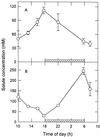Phloem Transport of Fructans in the Crassulacean Acid Metabolism Species Agave deserti
- PMID: 9490769
- PMCID: PMC35130
- DOI: 10.1104/pp.116.2.709
Phloem Transport of Fructans in the Crassulacean Acid Metabolism Species Agave deserti
Abstract
Four oligofructans (neokestose, 1-kestose, nystose, and an un-identified pentofructan) occurred in the vascular tissues and phloem sap of mature leaves of Agave deserti. Fructosyltransferases (responsible for fructan biosynthesis) also occurred in the vascular tissues. In contrast, oligofructans and fructosyltransferases were virtually absent from the chlorenchyma, suggesting that fructan biosynthesis was restricted to the vascular tissues. On a molar basis, these oligofructans accounted for 46% of the total soluble sugars in the vascular tissues (sucrose [Suc] for 26%) and for 19% in the phloem sap (fructose for 24% and Suc for 53%). The Suc concentration was 1.8 times higher in the cytosol of the chlorenchyma cells than in the phloem sap; the nystose concentration was 4.9 times higher and that of pentofructan was 3.2 times higher in the vascular tissues than in the phloem sap. To our knowledge, these results provide the first evidence that oligofructans are synthesized and transported in the phloem of higher plants. The polymer-trapping mechanism proposed for dicotyledonous C3 species may also be valid for oligofructan transport in monocotyledonous species, such as A. deserti, which may use a symplastic pathway for phloem loading of photosynthates in its mature leaves.
Figures


References
-
- Aspinall GO, Gupta PC. The structure of the fructosan from Agave vera-cruz Mill. J Am Chem Soc. 1959;81:718–722.
-
- Bhatia IS, Nandra KS. Studies on fructosyl transferase from Agave americana. Phytochemistry. 1979;18:923–927.
-
- Bradford MM. A rapid and sensitive method for the quantitation of microgram quantities of protein utilizing the principle of protein-dye binding. Anal Biochem. 1976;72:248–254. - PubMed
-
- Bush DR. Proton-coupled sugar and amino acid transporters in plants. Annu Rev Plant Physiol Plant Mol Biol. 1993;44:513–542.
-
- Cairns AJ. Evidence for the de novo synthesis of fructan by enzymes from higher plants: a reappraisal of the SST/FFT model. New Phytol. 1993;123:15–24.
LinkOut - more resources
Full Text Sources
Miscellaneous

